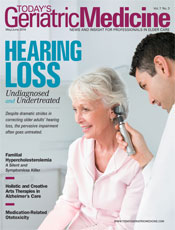
May/June 2014
Therapeutic Socialization Offers SupportBy Carolyn C. Tinglin, MSc, RN The prevalence of social isolation among older adults is increasingly problematic considering that by 2030, the population of adults older than 65 will make up 20% of the entire US population.1 Numerous studies have indicated that social isolation can predict poor health outcomes in the older adult population. Furthermore, social isolation is closely correlated with loneliness and depression. For instance, a large study by Tilvis et al showed that loneliness in elderly populations can significantly predict mortality risk.2 Health care practitioners working with older adults are challenged with the task of assessing patients’ isolation risk and offering treatments that promote social integration and patient autonomy in addition to addressing any physical or psychological manifestations present. Symptoms and Causes A variety of factors can contribute to social isolation. For example, environmental circumstances such as living alone, caring for a disabled or unwell spouse, experiencing little family contact, suffering from financial constraints, or living in rural areas can affect individuals. Communication barriers such as language difficulties, special needs, or the residual effects of stroke can be equally isolating, as can medical issues such as undiagnosed depression, chronic illness, physical mobility issues, dementia, urinary incontinence, or irritable bowel syndrome. Is Socialization Therapeutic? Preventing and Addressing Social Isolation The Lubben Social Network Scale is one resource that providers in various settings, including physicians’ offices, nursing homes, and assisted-living facilities, can use to evaluate patients’ social isolation risk. The 10-item scale measures the size, closeness, and frequency of an individual’s social network and the perceived support from friends, family, and neighbors. The scale also has been used successfully to assess specific populations of older adults, such as LGBT and childless elders. If the assessment indicates that the patient may also be at risk of depression, providers should perform further investigations in this area, employing the Patient Health Questionnaire-9 depression screening tool, for example. Once any suspicions about social isolation are confirmed, providers can suggest community resources and/or programs such as local seniors centers, community day programs for older adults, volunteer organizations such as Meals on Wheels or Seniors for Seniors, online social groups for older adults, and support groups for conditions such as Alzheimer’s and Parkinson’s diseases. Social recreation programs offer therapeutic socialization in community settings and provide older adults with the opportunity to socialize with other adults, exercise, challenge their minds, and enjoy planned outings and activities. Most programs operate Monday through Friday during the daytime hours. Program costs vary from $10 to $80 per day, depending on supplemental health coverage and household income. Social recreation programs benefit caregivers as well. They often are balancing full-time work and caregiving responsibilities, scrambling to make arrangements to ensure their loved ones’ safety and emotional security. In essence, social recreation programs offer peace of mind both for patients who live independently or those who have family support. Caregivers also are at high risk of isolation because of the amount and complexity of the care they provide, with the risk increasing in proportion to the complexity of patient care. Physical symptoms of social isolation among caregivers can provide clues that further assessment is necessary. Providers can use patients’ well visits to assess and evaluate the psychosocial well-being of family caregivers, particularly if there’s suspicion that the caregiver is at risk for depression, burnout, or isolation. Final Thoughts As the older adult population increases over the coming decades, practitioners will need to become more familiar with resources that can help combat social isolation. Social groups engage older adults in activities that promote positive communication, social skills, and cognitive stimulation. Social recreation programs meet the cognitive, psychosocial, and physical needs of patients at risk of social isolation while enabling individuals to remain at home in the community and helping to reduce multiple hospital and physician visits related to depression, failure to thrive, and inability to cope. — Carolyn C. Tinglin, MSc, RN, is a health consultant working with youths and adults with dual diagnoses of intellectual and development disabilities and mental health needs. She has worked extensively in long term care, specializing in psychogeriatrics throughout the United States and Canada. Case Study Fred is 78, obese, and has diabetes, congestive heart failure, and coronary artery disease, along with severe cognitive impairment due to advanced Alzheimer’s dementia. He depends on Marge for most of his personal care, meals, and transportation. Recently, Fred has been unable to sleep and his appetite has diminished, and he has been more agitated and irritable for the past week. Fred has an appointment scheduled with his physician today at 3 pm. Fred and Marge arrive at the physician’s office at 3:14. Marge appears despondent with flat affect, continues to rub her temples, and appears not to follow the conversation during the visit as she usually has. Providers should consider the following questions: • Are Fred’s symptoms new or out of the ordinary? • How does Fred’s health impact his quality of life? • How does Fred’s health impact his wife’s quality of life? • What are the couple’s priority needs? • What are some of the potential problems identified? — CCT References 2. Tilvis RS, Laitala V, Routasalo PE, Pitkälä KH. Suffering from loneliness indicates significant mortality risk of older people. J Aging Res. 2011;2011:534781. doi: 10.4061/2011/534781. 3. Nakahara J. Effects of social activities outside the home on life satisfaction among elderly people living alone. Int J Psycho Stud. 2013;5(1):112-130.
|
